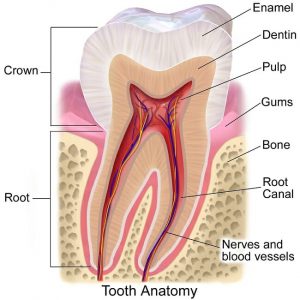
Teeth are hard, mineral-rich structures which are used to chew food. They are not made of bone like the rest of the skeleton, but have their own unique structure to enable them to break down food.
Tooth enamel is the most mineralized tissue in the body, consisting mainly of the rock-hard mineral hydroxyapatite. Hydroxyapatite is also found in some rocks and makes up part of the mineral/protein matrix of bones.
Some animals have the ability to replace their teeth throughout their lifespan, as teeth may be lost due to injury or disease. Humans have two sets of teeth: baby teeth which loosen and fall out prior to adulthood, and adult teeth which stay in place throughout adult life.
The shape and number of an animal’s teeth vary according to what they eat. Here we’ll discuss the functions of different types of teeth, as well as the structure and different tissues which make up human teeth.
Teeth assist animals in obtaining food and breaking it down for efficient digestion. Animals who lose their teeth are generally unable to ingest enough nutrients to survive.
The specific mechanical functions that teeth must perform depends on the animal’s food source. The animal may need to pierce skin and tear meat, grind up fibrous vegetables, or do some combination of the two.
Predators often boast sharp, pointed or even serrated teeth to assist them in taking down prey and eating raw meat.
Herbivores on the other hand typically have long, sharp incisors at the front of their mouths to assist in cutting bite-sized pieces off of plants and well as molars with broad, textured surfaces in the back of the mouth which grind and break down plant matter for easier digestion by the stomach.
Humans eat both meat and a variety of plant matter. As a result, we have several types of teeth which are good for breaking down different types of food:

The structure of a human tooth includes the following tissues:
The tooth is often broken down by dentists into the following major regions:
1. Why is it important to floss?
A. To prevent potentially dangerous bacteria from reaching the root of the tooth.
B. To prevent bacteria from eating away at the enamel of the tooth’s neck and crown.
C. To prevent infections from spreading from the tooth to other parts of the body.
D. All of the above.
D is correct. Both A and B are reasons why flossing is important to preserving the health of the teeth as well as the body.
2. What is likely the diet of an animal with sharp, shearing incisors in the front of the mouth and flat, grinding molars in the back?
A. A carnivorous diet of meat.
B. An omnivorous diet with both plants and meat.
C. A herbivorous diet of plants.
D. None of the above.
3. What is one possible consequence of injury or infection to a wild animal’s teeth?
A. The infection may spread to other parts of the body, potentially resulting in death.
B. The animal may not be able to ingest enough nutrients to survive.
C. In some species, the teeth may be replaced by a new set of teeth.
D. All of the above.
D is correct. All of the above are possible outcomes of injury or infection to the teeth of animal in the wild.